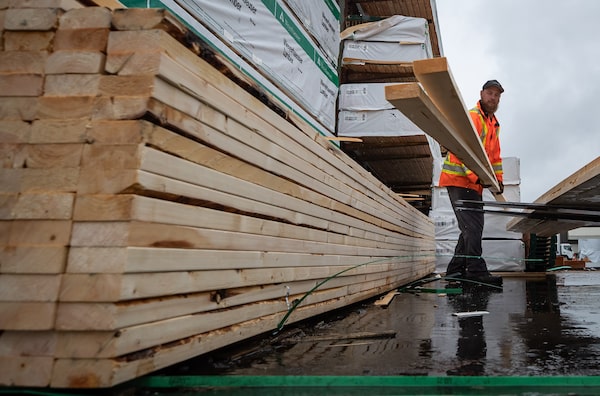
Lumber markets have been on a roller-coaster ride, after the COVID-19 pandemic initially eroded demand in the first half of 2020.DARRYL DYCK/The Canadian Press
Lumber prices have tumbled over the past 10 weeks as consumers retreat from do-it-yourself projects and builders slow the pace of housing starts.
Despite the 46-per-cent drop in prices since mid-March, relief won’t likely trickle down to consumers for at least four weeks, and recent prices are still twice as high as two years ago.
Cash prices – what sawmills charge wholesalers – are at US$750 for 1,000 board feet of two-by-fours made from Western spruce, pine and fir (SPF), according to Random Lengths, an Oregon-based company that monitors wood markets. The survey by Random Lengths shows prices fell US$150 last week to their lowest level in six months.
B.C.’s biggest forestry companies target U.S. lumber barons
On Wednesday, futures prices decreased 7 per cent, suggesting that further declines are likely in cash prices in June.
Lumber markets have been on a roller-coaster ride, after the COVID-19 pandemic initially eroded demand in the first half of 2020. In the summer of 2020, people stuck at home started a do-it-yourself bonanza, snapping up construction materials for decks, fences and renovations.
But with consumers having more options this year for using their disposable income, the market for repairs and remodelling has slumped, said Dustin Jalbert, senior economist at Fastmarkets, which publishes Random Lengths.
“People are travelling and out of the house now,” he said in an interview. “Consumer behaviour is shifting.”
The latest downturn marks the third time since the autumn of 2020 that cyclical lumber markets have sunk sharply after surging.
While consumer spending is increasing on services such as travel, there is belt-tightening with household budgets at the same time, Mr. Jalbert said.
“The consumer is being pinched by inflation right now. So you have a lot more disposable income that’s being tied up in higher food costs and higher energy costs,” he said. “Between inflation and higher interest rates, that’s kind of a brake on consumption and growth.”
Cash prices hit a record high in May of 2021, reaching US$1,630 for 1,000 board feet of two-by-fours made from Western SPF, before sinking in the second half of last year and then recovering again. Prices were as high as US$1,400 just 10 weeks ago.
Mr. Jalbert expects prices to be less volatile in the second half of 2022, and could eventually settle next year into a range of US$450 to US$600. In 2019, prior to the pandemic, lumber typically sold for US$350 to US$400.
Madison’s Lumber Reporter, a Vancouver-based industry newsletter, said in its weekly commentary that demand sagged further amid shortened work weeks in May, first with Victoria Day in Canada and then Memorial Day in the United States. “Producers found limited success enticing buyers, even with triple-digit price drops,” Madison’s said.
It will likely take four to six weeks before lower wholesale prices start being reflected at retail stores. Many outlets first need to sell inventory bought at higher prices, and those prices vary regionally.
“It all depends where you get the lumber, when it comes in and what’s available,” said Josh Cabral, manager of the Dunbar Lumber store in Vancouver.
A widely-used two-by-four framing wall stud that’s almost eight feet long sold for $7 at some Canadian retail outlets this week, down from $10.50 a year ago, but still higher than the $3.25 charged in early 2020.
On the Chicago Mercantile Exchange, prices for lumber futures for July delivery have fallen 54 per cent since early March. They slid US$49 for 1,000 board feet to close on Wednesday at US$604.50.
“High mill inventories and cautious customer buying patterns are both pressuring prices,” BMO Capital Markets analyst Mark Wilde said in a research note. “Transportation and logistics challenges in Western Canada are causing a backup in inventories at the sawmill level.”
Canfor Corp. CFP-T announced last week it will extend the slowdown of operations at its sawmills in Western Canada, saying its ability to transport lumber is being limited by continuing disruptions to the global supply chain. Since late March, Vancouver-based Canfor has been operating at about 80 per cent of its production capacity.
Congestion in the global supply chain is lingering as the Port of Vancouver and other hubs trying to process container shipments and various cargo run into rail and warehousing delays.
“We are working to bring our inventory levels back into balance by reducing our production,” said Canfor chief executive officer Don Kayne.
Canadian lumber shipments to the United States continue to be hit with softwood duties levied by the U.S. Department of Commerce, raising the price for American home builders and consumers.
“The U.S. is in the midst of a housing affordability crisis fuelled in part by lumber tariffs that are acting as a tax on American home buyers,” Jerry Konter, chairman of the U.S. National Association of Home Builders, said in a recent statement.
The 2006 Canada-U.S. softwood agreement expired in October, 2015, with no replacement. In the latest round of the trade dispute, Canadian producers have been paying U.S. lumber tariffs since April, 2017. The current duty rate is 17.91 per cent for most Canadian forestry firms, though that is scheduled to decrease this autumn.
Your time is valuable. Have the Top Business Headlines newsletter conveniently delivered to your inbox in the morning or evening. Sign up today.